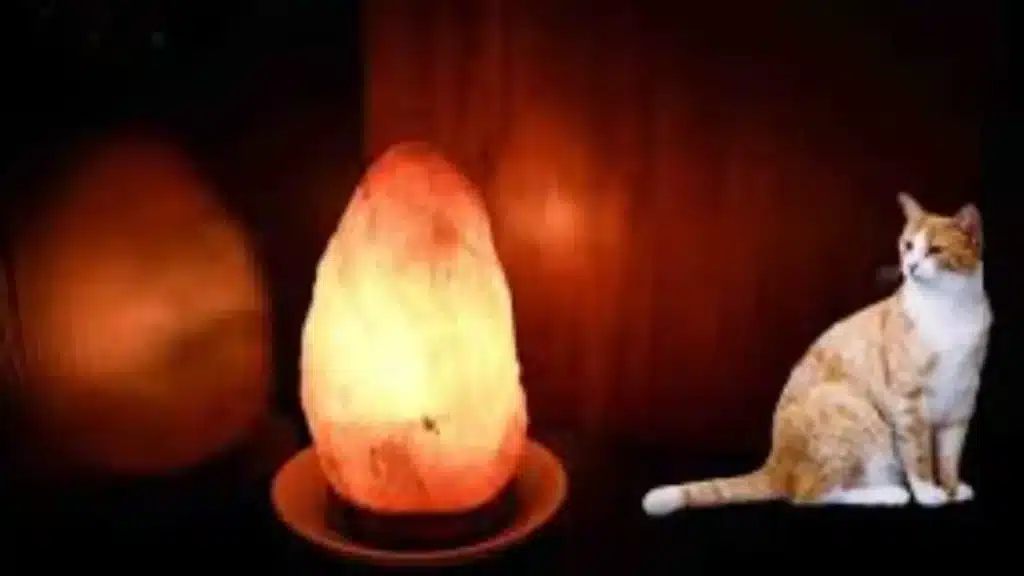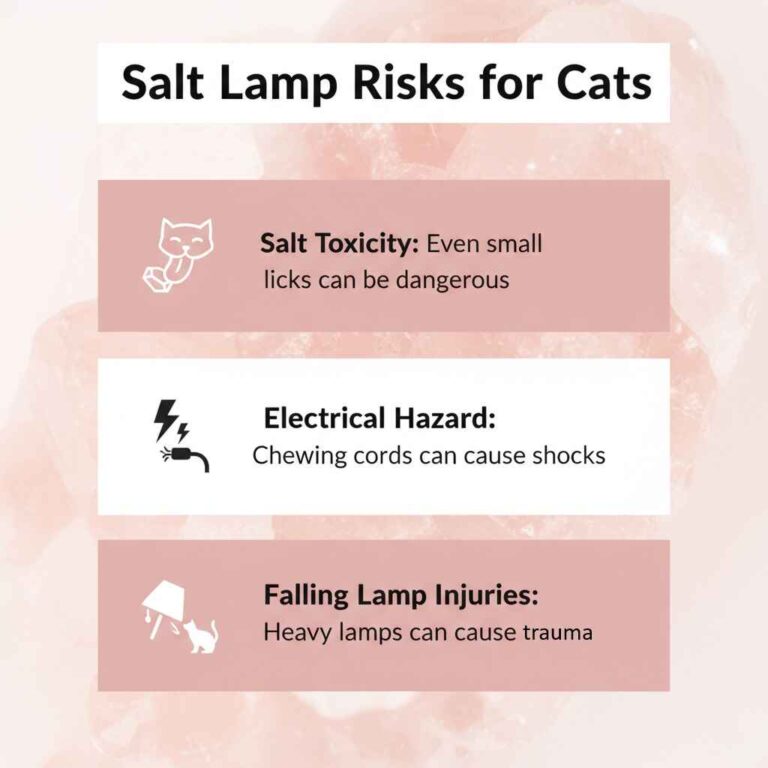Are Salt Lamps Bad for Cats? The Essential Guide for Pet Parents
- Zayan Rauf

Key takeaways
- Salt lamps can be risky for cats if they lick, chew, or knock them over.
- Salt toxicity (hypernatremia) can occur even from small amounts of salt ingestion.
- Cats are drawn to salt lamps because of the salty taste, warmth, and elevated placement.
- Risks include salt poisoning, electrical shock from cords, and injuries from falling lamps.
- You can keep a salt lamp safely by elevating it, securing it, covering cords, and monitoring your cat.
- Watch for warning signs like vomiting, disorientation, or tremors and contact a vet immediately.
- Whether using Sobaan Salts lamps or any brand, proper placement and precautions are essential for pet safety.
Himalayan salt lamps have surged in popularity for their soothing pink hue and purported air-purifying qualities, creating a serene vibe in many homes. Yet, for cat owners, a pressing concern lingers: Are salt lamps bad for cats? The concise answer is yes they pose risks if your feline friend licks, chews, or knocks them over. Excessive interaction can lead to serious health issues, from salt toxicity to injuries.
This guide breaks down the dangers, why cats are drawn to these lamps, and practical steps to safeguard your pet. Armed with this knowledge, you can balance ambiance and animal welfare.

Why Cats Gravitate Toward Salt Lamps
Felines are notorious explorers, driven by instinct to sniff, paw, and taste novel items. Salt lamps appeal to cats for several compelling reasons:
- The Irresistible Salty Flavor Cats possess taste buds attuned to umami and savory notes, making the sodium-rich surface of a Himalayan salt lamp enticing. Veterinary experts note that felines often lick salty substances out of innate curiosity or mild affinity for the taste.[1] If you have a Himalayan salt lamp from Sobaan Salts, make sure it is kept out of your cat’s reach to prevent repeated licking.
- Gentle Warmth and Texture When lit, these lamps emit a subtle heat, mimicking a cozy sunbeam that invites rubbing or lounging. The rough, crystalline texture also piques tactile interest.
- Elevated Adventure Zones Perched on shelves or end tables, salt lamps transform into high-stakes playgrounds. Cats’ acrobatic prowess turns these spots into prime targets for leaps and investigations.
This blend of sensory allure and exploratory drive turns a harmless decor piece into a potential hazard.
Read More: How To Choose Right Himalayan Salt Lamp A To Z Guide
Did You Know?
High sodium poisoning (hypernatremia) in cats is linked to a ~28% fatality rate, according to a major veterinary study.[8]
The Hidden Dangers of Salt Lamps for Cats
Beyond mere curiosity, unchecked access can trigger acute threats. Here’s how these lamps endanger cats. This is also why many pet owners keep wondering, “Are Salt Lamps Bad for Cats?” before placing one in their home.
1. Salt Toxicity and Hypernatremia
Repeated licking ingests high sodium levels, overwhelming a cat’s kidneys and causing hypernatremia a spike in blood sodium that disrupts cellular fluids.[2] This condition, also known as salt poisoning, demands immediate intervention to prevent fatality.[3]
Key symptoms include:
- Vomiting and diarrhea
- Intense thirst and frequent urination
- Lethargy or weakness
- Ataxia (unsteady gait)
- Tremors or seizures in advanced stages
Even small amounts far less than a teaspoon can tip the scales for a 10-pound cat, escalating to dehydration and neurological chaos.
2. Electrical Risks from Chewing
Playful nibbling on power cords is a feline favorite, but it invites electrocution. Chewed wires expose live currents, leading to oral burns, cardiac arrhythmias, or full shocks.[4] Signs of trouble? Excessive drooling, coughing, or refusal to eat prompt signs of internal damage.[5] Vulnerable kittens or wire-chewing adults face heightened peril, with fires as a rare but catastrophic outcome.
3. Tumble and Trauma Hazards
A mid-leap pounce can topple a hefty salt lamp, resulting in blunt force impacts. Veterinary data on feline falls reveals common traumas like fractures, lacerations, and soft-tissue contusions, especially to limbs and the head.[6] Heavier models (up to 20 pounds) amplify injury severity, potentially requiring surgical repair or euthanasia in dire cases.
Did You Know?
Electrical cord chewing is a real danger veterinarians report that when cats bite live wires, they can suffer arrhythmias, tremors, or even pulmonary edema.[9]
Can You Keep a Salt Lamp Safely with Cats? Absolutely With Smart Strategies
Don’t ditch your lamp just yet. Proactive measures let you enjoy its glow risk-free:
✔ Elevate and Secure
Mount on tall, stable ledges beyond jumping range. Wall sconces or enclosed cabinets work wonders.
✔ Shield the Cord
Wrap wires in bitter-tasting covers or tuck them behind furniture. Deterrent sprays add an extra barrier.
✔ Vigilant Supervision
Observe initial interactions; relocate if licking persists. Fresh water bowls nearby curb thirst-driven temptations.
✔ Opt for Low-Heat Alternatives
LED-bulb versions stay cooler, reducing burn risks and appeal.
✔ Strategic Spotting
Steer clear of wobbly surfaces or cat highways like windowsills. Holiday setups? Double-check for stability.[7]
These tweaks minimize exposure while preserving your home’s zen.
Read More: How To Identify A Fake Himalayan Salt Lamp A Complete Guide
Urgent Signs: When to Rush to the Vet
Spot vomiting, disorientation, or excessive panting post-lamp encounter? Act fast salt imbalances worsen rapidly, risking brain swelling or organ failure. Call your vet or an emergency clinic; treatments like IV fluids and electrolyte correction boast high success rates if caught early.
Final Thoughts: Harmony for Home and Whiskers
So, are salt lamps bad for cats? The answer depends on how accessible the lamp is and how curious your cat tends to be. Not inherently, but their sodium payload and setup vulnerabilities make them a sneaky foe for curious climbers. By understanding feline instincts and implementing barriers, you sidestep salt toxicity, shocks, and spills. Prioritize precautions, and your space stays inviting for humans and cats alike. Whether you buy from Sobaan Salts or any trusted brand, careful placement is key to keeping your cats safe.Your pet’s tail-wagging trust is worth every adjustment.
References
- Dial a Vet. (n.d.). Do cats actually like the taste of salt or am I just imagining things? Dial a Vet.
- Chew, D., & DiBartola, S. (2017). A quick reference on hypernatremia. Veterinary Clinics of North America: Small Animal Practice, 47(3), 295–306.
- Kasai, C. M., et al. (2009). Hypernatremia. Compendium on Continuing Education for the Practising Veterinarian, 31(4), E1–E6.
- MSPCA-Angell. (n.d.). Electrical cord injury. MSPCA-Angell Animal Medical Center.
- Garden State Veterinary Specialists. (2025, May 29). What to do if your cat chews an electrical cord: Urgent steps & prevention. GSVS.
- Andrade, M. C., et al. (2025). High-rise syndrome in cats (part 2): Injury patterns and survival rate. Journal of Feline Medicine and Surgery, 27(5), Article 1098612X251334096.
- American Veterinary Medical Association. (n.d.). Winter holiday pet safety. AVMA.
- J Vet Intern Med (2015). Incidence, severity and prognosis associated with hypernatremia in dogs and cats.
- PetMD. Michael Kearley, DVM. Electrocution in Cats. Published June 9, 2023.
Share This Post
Article By

